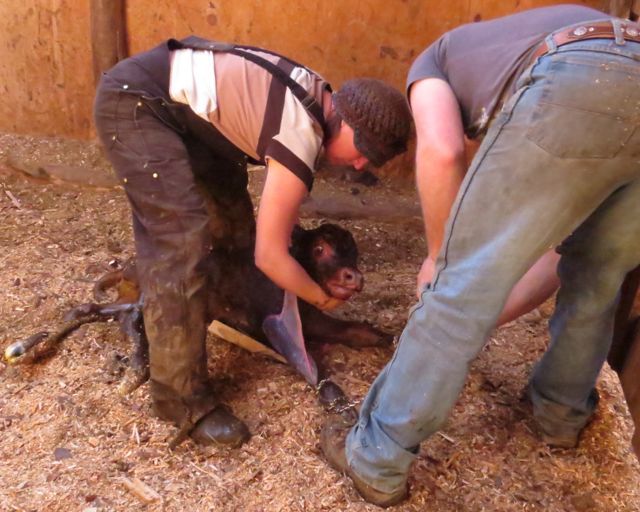 You might remember this picture from the last post. In fact, the heifer that produced this calf needed some assistance. I got some great shots of the process – I have pulled calves many times myself – but Punky asked me not to publish the photos, and here are her comments about it.
You might remember this picture from the last post. In fact, the heifer that produced this calf needed some assistance. I got some great shots of the process – I have pulled calves many times myself – but Punky asked me not to publish the photos, and here are her comments about it.
Chris took some nice shots of Paul and I pulling a calf. After viewing, I asked her not to post them. But not because I felt uncomfortable or guilty about what we had done, but because once a photo is put out for the public, you no longer have any control over it. (It is very weird to see photos I’ve put on my blog when “Anahim Lake” is googled….. how did they get there? Who decided what?)
I’ll give you a tiny bit of background. The cow is a ‘first calver’ and this year we have had too many ‘big’ calves and have had to assist more times than usual. Why? That is the big question at the moment. And one I don’t have an answer to yet. Hence researching bulls, talking to our vet, and gathering any information I can pull together. Meanwhile back at the ranch, our heifers are strong, healthy and mothering their ‘too big’ calves beautifully. Just too often needing a bit of help (that should not be necessary) to give birth. Or the calf would die. And so would the momma. This is despite our careful and very specific selection of suitable bulls, our strict ‘pasture breeding’ so there are no mistakes or surprises with bulls meant for older cows, keeping our own known heifers (rather than buying) and all the other extra care and attention that the heifers get.
The carefully watched heifer in question has not been progressing quickly enough and it was well time to lend a hand. She quietly walked in to the maternity chute and I was able to easily set the chains. The first loop is set above the fetlock joint, and the other half hitched below the joint, below the dew claws. This means that the pressure is distributed between two points, not just concentrated in one spot. Obviously set the same on each individual front leg. We are then careful to guide the calf correctly and slowly in to position, in this case pulling the legs one at a time to start out with. While big, the calf was mostly just ‘bunched up’ and once we had his shoulders “walked” in to the birth canal, he came relatively easy. We are conscious of doing this procedure as naturally and thoughtfully as possible. We work with the cow, pulling with her contractions, and keeping the process in stages (as it would be without our help), allowing the calf’s lungs to drain, (we can help clear them if necessary) and encouraging him to take his first breaths once far enough out of his mother to do so. Once born, we quickly move him out of the way (so his mother can safely back out of the head gate without stepping on him) and set the calf in a position best suited to help expand his lungs. Healthy mother and baby are immediately left alone to get used to the new situation and bond without distraction.
But none of this information or understanding will you get from any still photos. I would usually agree that a photo is worth a thousand words, but in this case, it’s also about perspective.
I can almost see the caption above the picture on Facebook now… “Two hundred pound man carelessly rips calf from confined and helpless cow while woman smiles and assists. If you are against such animal cruelty, ‘like and share’ this horrible photo. Donate now to……”
See what I mean? If you are on Facebook or Twitter, or probably any of a hundred other social media sites, you’ve seen something similar.
No thanks.
Ranchers often get a raw deal from the public. Sure, we all condemn feedlot beef it is unnatural, unhealthy for the cow, and therefore unhealthy for the human that eats it. Range meat has a perfect ratio of omega 3 to omega 6 fats. The fat itself has no chemicals. Unlike feedlot beef that has a very high omega 6 percentage, whose fat is full of poisons, and who would not live much past slaughtering age because the liver disintegrates due to its unnatural diet. I live in an area where decent food is very hard to get especially in winter. How lucky I am to at least have real meat.
